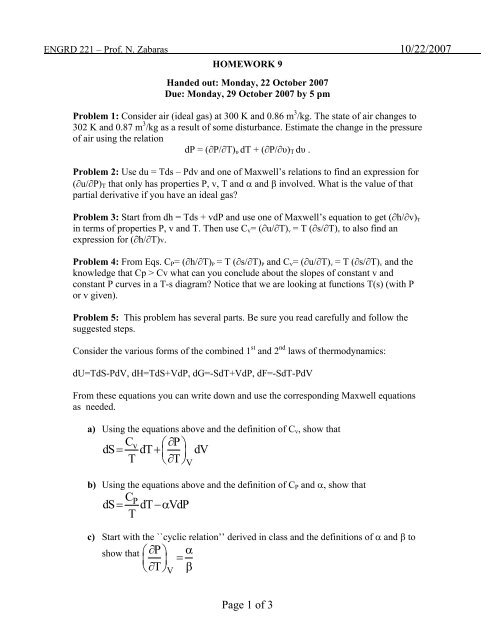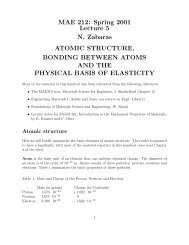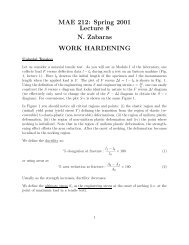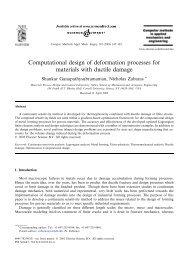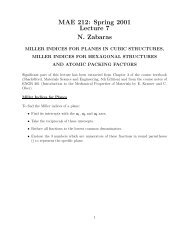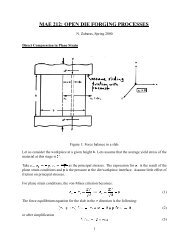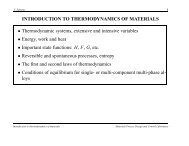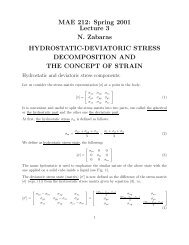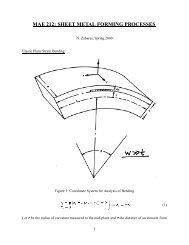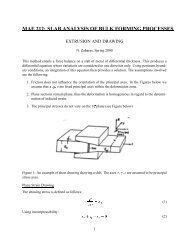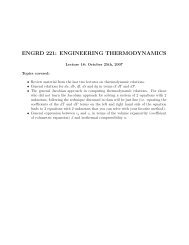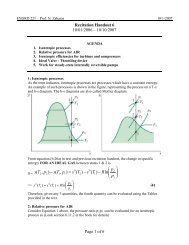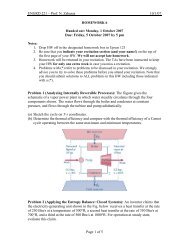C P dS dT dV T T ââ â = +â â ââ â C dS dT VdP T = âα P T â α ...
C P dS dT dV T T ââ â = +â â ââ â C dS dT VdP T = âα P T â α ...
C P dS dT dV T T ââ â = +â â ââ â C dS dT VdP T = âα P T â α ...
You also want an ePaper? Increase the reach of your titles
YUMPU automatically turns print PDFs into web optimized ePapers that Google loves.
ENGRD 221 – Prof. N. Zabaras 10/22/2007<br />
HOMEWORK 9<br />
Handed out: Monday, 22 October 2007<br />
Due: Monday, 29 October 2007 by 5 pm<br />
Problem 1: Consider air (ideal gas) at 300 K and 0.86 m 3 /kg. The state of air changes to<br />
302 K and 0.87 m 3 /kg as a result of some disturbance. Estimate the change in the pressure<br />
of air using the relation<br />
dP = (∂P/∂T) υ <strong>dT</strong> + (∂P/∂υ) T dυ .<br />
Problem 2: Use du = Tds – Pdv and one of Maxwell’s relations to find an expression for<br />
(∂u/∂P) T that only has properties P, v, T and α and β involved. What is the value of that<br />
partial derivative if you have an ideal gas?<br />
Problem 3: Start from dh = Tds + vdP and use one of Maxwell’s equation to get (∂h/∂v) T<br />
in terms of properties P, v and T. Then use C v = (∂u/∂T) v = T (∂s/∂T) v to also find an<br />
expression for (∂h/∂T)v.<br />
Problem 4: From Eqs. C P = (∂h/∂T) P = T (∂s/∂T) P and C v = (∂u/∂T) v = T (∂s/∂T) v and the<br />
knowledge that Cp > Cv what can you conclude about the slopes of constant v and<br />
constant P curves in a T-s diagram? Notice that we are looking at functions T(s) (with P<br />
or v given).<br />
Problem 5: This problem has several parts. Be sure you read carefully and follow the<br />
suggested steps.<br />
Consider the various forms of the combined 1 st and 2 nd laws of thermodynamics:<br />
dU=T<strong>dS</strong>-P<strong>dV</strong>, dH=T<strong>dS</strong>+<strong>VdP</strong>, dG=-S<strong>dT</strong>+<strong>VdP</strong>, dF=-S<strong>dT</strong>-P<strong>dV</strong><br />
From these equations you can write down and use the corresponding Maxwell equations<br />
as needed.<br />
a) Using the equations above and the definition of C v , show that<br />
Cv<br />
⎛∂P<br />
⎞<br />
<strong>dS</strong> = <strong>dT</strong> +⎜ ⎟ <strong>dV</strong><br />
T ⎝∂T⎠<br />
V<br />
b) Using the equations above and the definition of C P and α, show that<br />
C P<br />
<strong>dS</strong> = <strong>dT</strong> −α <strong>VdP</strong><br />
T<br />
c) Start with the ``cyclic relation’’ derived in class and the definitions of α and β to<br />
show that ⎛∂P<br />
⎞ α<br />
⎜ ⎟<br />
⎝∂T<br />
⎠<br />
V<br />
=<br />
β<br />
Page 1 of 3
ENGRD 221 – Prof. N. Zabaras 10/22/2007<br />
d) Equate the results from Part 1 and 2 and use part 3 to show the following:<br />
Cp<br />
− Cv<br />
β<br />
<strong>dV</strong> = <strong>dT</strong> −β<strong>VdP</strong><br />
T α<br />
e) In class we derive in expression of <strong>dV</strong> in terms of <strong>dT</strong> and dP using the definitions<br />
of α and β (Hint: to arrive at this equation, start from<br />
⎛∂V⎞ ⎛∂V⎞<br />
<strong>dV</strong> = ⎜ ⎟ <strong>dT</strong> + ⎜ ⎟ dP<br />
⎝∂T⎠ ⎝∂P⎠<br />
P<br />
T<br />
with the result in part 4 above to show that:<br />
2<br />
C − C = T α<br />
v<br />
). Equate the simplification of this expression<br />
p v<br />
β<br />
f) Consider an ideal gas (PV=RT). Derive simplified expressions for α and β (in<br />
terms of P,T or V) and then simplify the equation in Part 5 to a familiar form for<br />
ideal gases.<br />
Problem 6: Use the methodology of your choice to compute an expression for<br />
in terms of T, P, α and β.<br />
⎛∂V<br />
⎞<br />
⎜ ⎟<br />
⎝∂U<br />
⎠<br />
T<br />
Problem 7: Which of the following relation(s) is correct?<br />
C<br />
p<br />
(a) dU = T<strong>dS</strong> − P<strong>dV</strong><br />
(b) <strong>dS</strong> = <strong>dT</strong> − VαdP<br />
T<br />
⎛<br />
dH = C<br />
p<strong>dT</strong> + V 1− Tα<br />
dP (d)<br />
PV ⎞<br />
dF = − ⎜S + <strong>dT</strong> −<strong>VdP</strong><br />
⎜⎝ T ⎠⎟<br />
(c) ( )<br />
Problem 8: Consider the following equation<br />
of the following statements is true and why?<br />
⎛ ∂P<br />
⎞<br />
⎜ ⎟<br />
∂V<br />
⎛∂V<br />
⎞ ⎛∂T<br />
⎞<br />
⎜ ⎟ ⎜ ⎟<br />
⎝∂T<br />
⎠ ⎝∂P<br />
⎠V<br />
⎝ ⎠T<br />
P<br />
= -1 . Which<br />
(a) the equation is valid only for ideal gases (PV=RT),<br />
(b) the equation is valid only for polytropic processes PV n =const,<br />
(c) the equation is valid for ideal gases (PV=RT) in isentropic processes (PV n =const), \<br />
(d) for all P-V-T state relations in solids, gases and liquids<br />
(e) valid for all P-V-T state equations of gases and liquids but not solids<br />
Problem 9:<br />
Page 2 of 3
ENGRD 221 – Prof. N. Zabaras 10/22/2007<br />
(a) Using the combined 1 st and 2 nd laws, dU = T <strong>dS</strong> – P <strong>dV</strong>, the definition of<br />
Maxwell relation,<br />
⎛∂P⎞ ⎛ ∂S⎞<br />
⎜ ⎟ = ⎜ ⎟<br />
⎝∂T⎠ ⎝∂V⎠ V<br />
relation (where familiar notation is used):<br />
T<br />
Cv<br />
and the<br />
, prove the following thermodynamic<br />
⎡ ⎛∂P<br />
⎞ ⎤<br />
dU = Cv<strong>dT</strong> + ⎢T⎜<br />
⎟ −P <strong>dV</strong><br />
T<br />
⎥<br />
⎣ ⎝∂<br />
⎠V<br />
⎦<br />
(Equation 1)<br />
(b) Applying the concept of exact differential to Equation 1<br />
show that:<br />
⎛∂Cv<br />
⎞ ⎛∂<br />
P ⎞<br />
⎜ ⎟ = T⎜ v<br />
2 ⎟<br />
⎝ ∂ ⎠T<br />
⎝∂T<br />
⎠<br />
2<br />
V<br />
(Equation 2)<br />
(c) We have used in many occasions in this course that the specific energy U of an ideal<br />
gas is only a function of temperature T. Prove that this is indeed the case starting from<br />
Equations (1) and (2) above and using PV=RT for an ideal gas.<br />
Page 3 of 3


